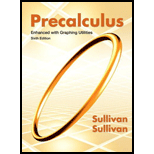
Extended Principle of Mathematical Induction The Extended Principle of Mathematical Induction states that if Conditions a and b hold, that is,
a. A statement is true for a natural number .
b. If the statement is true for some natural number , then it is also true for the next natural number .
Then the statement is true for all natural numbers
. Use the Extended Principle of Mathematical Induction to show that the number of diagonals in a convex
[Hint: Begin by showing that the result is true when (Condition (a).]
To prove: The statement
‘The number of diagonals in a convex polygon of sides is ’ is true for all natural numbers using the Extended Principle of Mathematical Induction.
Answer to Problem 32AYU
The statement is true for the natural number terms, it is true for all natural numbers
Explanation of Solution
Given:
Statements says
‘The number of diagonals in a convex polygon of
Formula used:
The Extended Principle of Mathematical Induction
Suppose that the following two conditions are satisfied with regard to a statement about natural numbers:
CONDITION I: A statement is true for a natural number
CONDITION II: If the statement is true for some natural number
Proof:
Consider the statement
‘The number of diagonals in a convex polygon of
Step 1: Show that statement (1) is true for the natural number
Number of sides = 4. 4-sided polygon is nothing but quadrilateral. In general, quadrilateral has two diagonals. Hence the statement is true for the natural number
Step 2: Assume that the statement is true for some natural number
That is ‘The number of diagonals in a convex polygon of
Step 3: Prove that the statement is true for the next natural number
‘The number of diagonals in a convex polygon of
For a convex n-sided polygon, there are n vertices and from each vertex you can draw
From equation (2), it can be concluded that for
For
For
For
For
In general, for
So the number of diagonals in a convex polygon of
As the statement is true for the natural number
Chapter 12 Solutions
Precalculus Enhanced with Graphing Utilities
Additional Math Textbook Solutions
University Calculus: Early Transcendentals (4th Edition)
Calculus and Its Applications (11th Edition)
Calculus: Early Transcendentals (3rd Edition)
Glencoe Math Accelerated, Student Edition
 Calculus: Early TranscendentalsCalculusISBN:9781285741550Author:James StewartPublisher:Cengage Learning
Calculus: Early TranscendentalsCalculusISBN:9781285741550Author:James StewartPublisher:Cengage Learning Thomas' Calculus (14th Edition)CalculusISBN:9780134438986Author:Joel R. Hass, Christopher E. Heil, Maurice D. WeirPublisher:PEARSON
Thomas' Calculus (14th Edition)CalculusISBN:9780134438986Author:Joel R. Hass, Christopher E. Heil, Maurice D. WeirPublisher:PEARSON Calculus: Early Transcendentals (3rd Edition)CalculusISBN:9780134763644Author:William L. Briggs, Lyle Cochran, Bernard Gillett, Eric SchulzPublisher:PEARSON
Calculus: Early Transcendentals (3rd Edition)CalculusISBN:9780134763644Author:William L. Briggs, Lyle Cochran, Bernard Gillett, Eric SchulzPublisher:PEARSON Calculus: Early TranscendentalsCalculusISBN:9781319050740Author:Jon Rogawski, Colin Adams, Robert FranzosaPublisher:W. H. Freeman
Calculus: Early TranscendentalsCalculusISBN:9781319050740Author:Jon Rogawski, Colin Adams, Robert FranzosaPublisher:W. H. Freeman
 Calculus: Early Transcendental FunctionsCalculusISBN:9781337552516Author:Ron Larson, Bruce H. EdwardsPublisher:Cengage Learning
Calculus: Early Transcendental FunctionsCalculusISBN:9781337552516Author:Ron Larson, Bruce H. EdwardsPublisher:Cengage Learning





